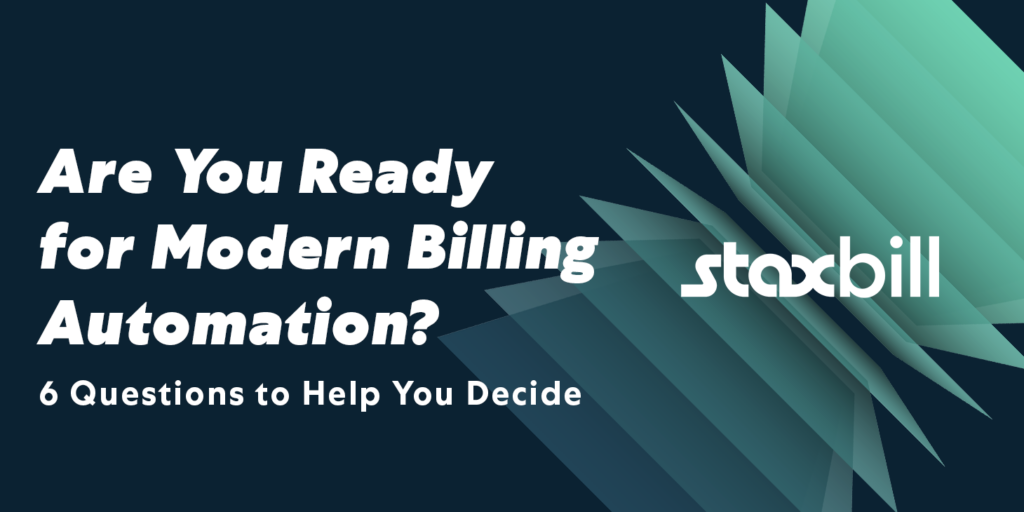You’re ramping up your subscription business and excited about its momentum. Keeping up with your billing, however, means juggling more and more spreadsheets as you grow. If this sounds like you, it’s time to ask yourself, “Have I hit the point in the road where it’s time to automate my billing?”
Here are a few solid indicators to help you decide…
1. How long does it take you to process a new order?
Automation speeds up the delivery of invoices without having to lift a finger, based on the settings you create. Processing orders manually takes, on average, 5 times longer than an automated process. Plus, manual processing means touching the data more often, which increases the likelihood of making mistakes. Mistakes cost you time and money, which could damage your company’s credibility, leading to customer satisfaction issues and, ultimately, customer churn. Equally troubling is that, as your business scales, errors will have a compounded effect and will trickle-down through other facets of your organization.
2. Is it easy to identify outstanding payments and which customers are overdue?
You should be able to identify outstanding payments instantly. With automation, a collections report provides a snapshot of your month and week to come so you have a clear view of what payments are expected on any given day. You are also able to identify customers who are late on their payments and schedule a reminder email to be sent automatically through your system. In addition, a billing system will enable you to implement dunning management into your collection processes – allowing you to automatically retry defaulted payments.
Automating your collection processes will save you a tremendous amount of time and frustration and help to keep your cash flow consistent.
3. When you process an upgrade or downgrade, how many steps does it take?
Manual changes to your pricing or packaging (upgrade, downgrade) are very complex and cumbersome. It means canceling one subscription, or part of a subscription, replacing it with another, then making the changes on the back end so your books will reflect your revenue recognition rules. Managing this through manual processes is time-consuming and complex, making it extremely error-prone. Ultimately these challenges create a deterrent to promoting new subscription plans – which would improve customer choice, increase customer satisfaction and lead to increased revenue.
Being able to upgrade or downgrade easily through a subscription billing platform enables you to capitalize on every opportunity to maximize revenue and retain customers.
4. How long does it take to close the books at month-end?
If you are manually working with supplementary spreadsheets, this process will slow things down considerably and the likelihood of making errors is high – because we’re only human.
Revenue recognition driven by a manual process consumes vast amounts of time, especially for a recurring revenue business – a problem that only grows as the business scales. Managing the month-end close process takes 80% less time when driven by an automated billing and revenue recognition process.
5. Do you have access to real-time financial data for decision-making?
Today’s line-of-business managers need real-time financial data to make smart decisions. Real-time and accurate financial data allows Sales and Marketing teams to capitalize on customer trends and allows Customer Satisfaction teams to head off problems with customers who may be at risk. If you are working with spreadsheets, it’s next to impossible to keep up with your recurring revenue, not to mention your revenue recognition. Revenue recognition reflects the true extent of revenue earned during a specific period. Billing automation provides “Set it and forget it” revenue recognition, which means you always have real-time metrics to make informed decisions.
It is important to keep an eye on key subscription metrics as they are important indicators of your business’ health. You will want to have a single pane that shows you how your business performed yesterday, last week, last month or last year. You will also benefit from insight into your customer base so your platform should track churn and acquisition rates. This information will help you fine-tune your service offerings and maximize subscription revenue.
Some important business health indicators are the following:
- Total Customer Value (TCV)
- Monthly Recurring Revenue (MRR)
- Annual Recurring Revenue (ARR)
- Cash Flow
- Customer Churn
- Customer Lifetime Value (CLV)
- Customer Acquisition Cost (CAC)
- Product/Subscription Sales
- Earned Revenues
6. Does your reporting measure the performance of your pricing strategies or marketing campaigns?
Subscription reporting also provides valuable insight into which services are most popular within your customer base. You will want to see how different products and services are performing. For example, cohort reports give you the ability to breakdown customer data e.g. geography or price. This way you can test out different strategies to find which option maximizes your revenue.

